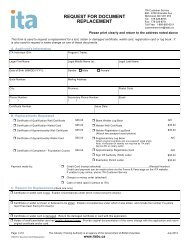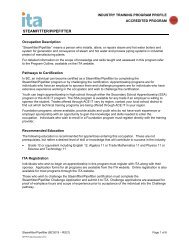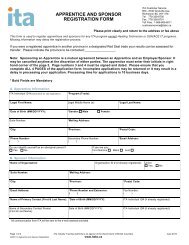CITO - Phase I Report - Industry Training Authority
CITO - Phase I Report - Industry Training Authority
CITO - Phase I Report - Industry Training Authority
You also want an ePaper? Increase the reach of your titles
YUMPU automatically turns print PDFs into web optimized ePapers that Google loves.
FERENCE WEICKER & COMPANY<br />
OVERVIEW OF THE ORGANIZATIONAL MODEL<br />
III. OVERVIEW OF THE ORGANIZATIONAL MODEL<br />
This chapter provides a preliminary overview of the organizational model including the functions of an<br />
<strong>Industry</strong> <strong>Training</strong> Organization, the existing structure of <strong>CITO</strong>, the primary functions of <strong>CITO</strong>, the<br />
development of functional profiles, and possible criteria for evaluating options.<br />
A. INDUSTRY TRAINING ORGANIZATIONS<br />
1. Three Stage Process<br />
Since 2004, the <strong>Industry</strong> <strong>Training</strong> <strong>Authority</strong> (ITA) has had legislated responsibility to govern and develop<br />
the industry training system in BC. <strong>Industry</strong> <strong>Training</strong> Organizations (ITOs) such as <strong>CITO</strong> are created by the<br />
ITA to be responsible for improving industry training in a specific sector. They are not-for-profit legal entities<br />
with responsibility for designated industry training programs.<br />
The ITOs are developed in a three stage process encompassing start-up, developmental and full-service<br />
delivery.<br />
� The start-up phase includes the basic organizational structures, hiring of key staff and establishing<br />
an office. This has been completed for <strong>CITO</strong>.<br />
� The developmental phase sees the ITO assuming some of the core responsibilities that are part of<br />
its mandate and beginning to take a lead role in a number of areas related to specific trades<br />
programs and industry requirements. These include areas such as developing an annual service<br />
plan for the organization, communications, updating program standards, forecasting training<br />
demand, and developing an annual training plan for the institutions and colleges who deliver<br />
technical training for apprentices and foundation programs (ELTT).<br />
� The final or full-service delivery stage involves an ITO assuming full responsibility for the services<br />
and tasks identified by the ITA.<br />
2. ITO Operational Principles<br />
ITOs are responsible to ITA and ITA is responsible to the Government of British Columbia. The ITA retains<br />
the principal training funding function as well as being the final authority for approving standards, training<br />
plans and evaluation techniques. Some of the operational policies and principles established by the ITA to<br />
govern the operations of an ITO include the following:<br />
� The system shall be industry led. <strong>Industry</strong> is best positioned and qualified to determine its own<br />
training needs and to coordinate the system. ITOs are industry-based bodies that take lead<br />
responsibility for industry training within a recognized industry sector. ITOs are initiated and<br />
supported by industry and approved by the ITA. All Board members must be from industry<br />
employers. Substantial industry commitment and participation is critical to the success of the ITO<br />
model.<br />
� <strong>Training</strong> standards is the core function. ITOs are training standards bodies and are prohibited<br />
from undertaking lobbying activities on behalf of industry.<br />
� ITOs have a high degree of autonomy. Autonomy of ITOs is required to produce results and this<br />
autonomy must be balanced with the ITA’s overall accountability to government for the industry<br />
Development of a Full-Service Model for <strong>CITO</strong> Page 25












